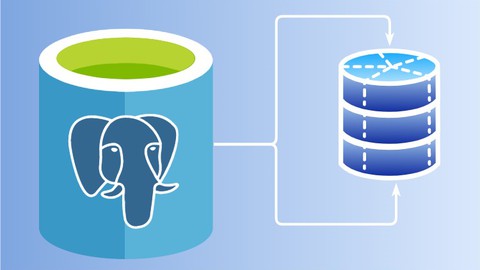
PostgreSQL Partitioning. Before 2GB frontier
PostgreSQL Partitioning. Before 2GB frontier, available at $19.99, has an average rating of 3.25, with 27 lectures, 1 quizzes, based on 4 reviews, and has 24 subscribers.
You will learn about Foundations of table partitioning in PostgreSQL Declarative and inheritance partitioning in PostgreSQL Why and when use different types of the partitioning Skills to analyze conditions for the partitioning introduction This course is ideal for individuals who are Software developers or Database administrators or Web developers or Site reliability engineer It is particularly useful for Software developers or Database administrators or Web developers or Site reliability engineer.
Enroll now: PostgreSQL Partitioning. Before 2GB frontier
Summary
Title: PostgreSQL Partitioning. Before 2GB frontier
Price: $19.99
Average Rating: 3.25
Number of Lectures: 27
Number of Quizzes: 1
Number of Published Lectures: 24
Number of Published Quizzes: 1
Number of Curriculum Items: 28
Number of Published Curriculum Objects: 25
Original Price: $19.99
Quality Status: approved
Status: Live
What You Will Learn
- Foundations of table partitioning in PostgreSQL
- Declarative and inheritance partitioning in PostgreSQL
- Why and when use different types of the partitioning
- Skills to analyze conditions for the partitioning introduction
Who Should Attend
- Software developers
- Database administrators
- Web developers
- Site reliability engineer
Target Audiences
- Software developers
- Database administrators
- Web developers
- Site reliability engineer
The partitioning is one of the important PostgreSQL features which may help you not only improve the performance of your application but also make your life easier as a software developer or database administrator.
One of the reason why I created this course is to understand how right the popular statement that the partitioning make sense for tables which size is greater than 2GB. Also in the Internet it’s possible to find many statements saying that the partitioning improves the maintainability and availability but what it means in practice. What exactly from the maintainability and availability point of view can be improved by using the partitioning.
Another reason is in my practice it happened pretty often that the developers were experiencing issues with understanding when the partitioning has to be introduced. So I hope this course will help you to recognize the need in the partitioning in your projects.
In this course we will look how we can analyze the query performance to understand we will get the benefits from the partitioning. Also I will show what particular advantages the partition may provide from availability and maintainability point of view. Also we will discuss different approaches for the partitioning among PostgreSQL versions and different types of the partitioning.
There are practical lessons where you find the step by step instructions for the performance analysis and partitioning implementation.
Course Curriculum
Chapter 1: Introduction
Lecture 1: Introduction
Lecture 2: What is partitioning
Lecture 3: Prepare demo database
Chapter 2: When we should use partitioning
Lecture 1: Analyze query performance
Lecture 2: Practice. Analyze query performance
Lecture 3: Analyze availability
Lecture 4: Practice. Analyze availability
Lecture 5: Analyze maintainability
Lecture 6: Analyze of table size
Chapter 3: The partitioning implementation
Lecture 1: Constraints
Lecture 2: Overview of the partitioning implementations
Lecture 3: Partition key. Data routing
Lecture 4: Partitioning by Range
Lecture 5: Practice. Partitioning by Range
Lecture 6: Partitioning by List
Lecture 7: Practice. Partitioning by List
Lecture 8: Partitioning by Hash
Lecture 9: Practice. Partitioning by Hash
Lecture 10: Constraint exclusion and partition pruning
Lecture 11: Partition level settings
Chapter 4: Limitations of partitioning
Lecture 1: Primary key limitations
Lecture 2: Index limitations
Chapter 5: Effect of partitioning
Lecture 1: Analyze query performance
Lecture 2: Analyze availability
Instructors
-

Mikhail Diakov
Software Architect
Rating Distribution
- 1 stars: 1 votes
- 2 stars: 1 votes
- 3 stars: 0 votes
- 4 stars: 1 votes
- 5 stars: 1 votes
Frequently Asked Questions
How long do I have access to the course materials?
You can view and review the lecture materials indefinitely, like an on-demand channel.
Can I take my courses with me wherever I go?
Definitely! If you have an internet connection, courses on Udemy are available on any device at any time. If you don’t have an internet connection, some instructors also let their students download course lectures. That’s up to the instructor though, so make sure you get on their good side!
You may also like
- Digital Marketing Foundation Course
- Google Shopping Ads Digital Marketing Course
- Multi Cloud Infrastructure for beginners
- Master Lead Generation: Grow Subscribers & Sales with Popups
- Complete Copywriting System : write to sell with ease
- Product Positioning Masterclass: Unlock Market Traction
- How to Promote Your Webinar and Get More Attendees?
- Digital Marketing Courses
- Create music with Artificial Intelligence in this new market
- Create CONVERTING UGC Content So Brands Will Pay You More
- Podcast: The top 8 ways to monetize by Podcasting
- TikTok Marketing Mastery: Learn to Grow & Go Viral
- Free Digital Marketing Basics Course in Hindi
- MailChimp Free Mailing Lists: MailChimp Email Marketing
- Automate Digital Marketing & Social Media with Generative AI
- Google Ads MasterClass – All Advanced Features
- Online Course Creator: Create & Sell Online Courses Today!
- Introduction to SEO – Basic Principles of SEO
- Affiliate Marketing For Beginners: Go From Novice To Pro
- Effective Website Planning Made Simple




















